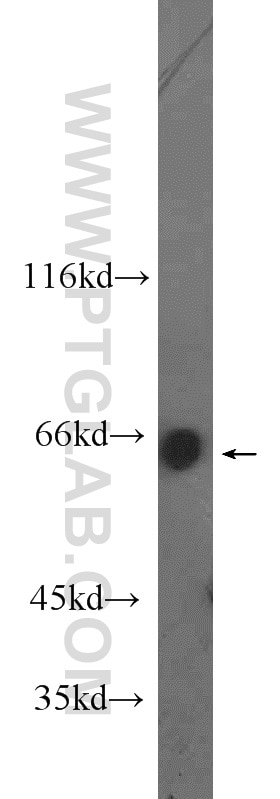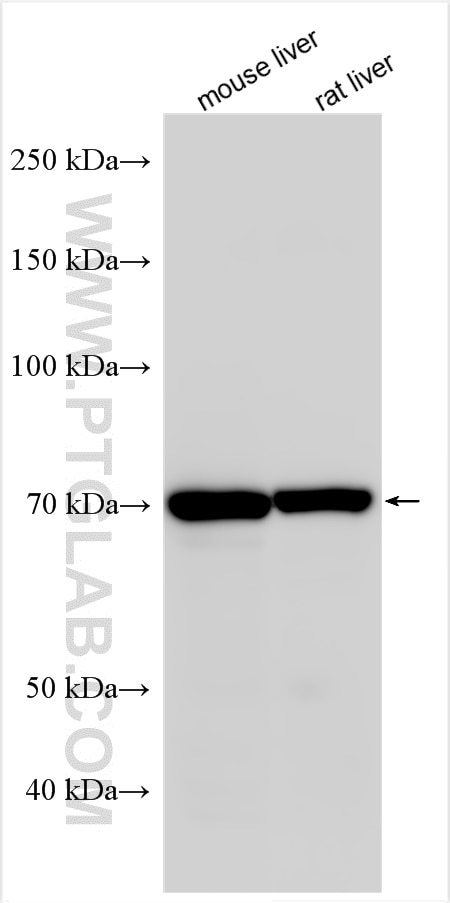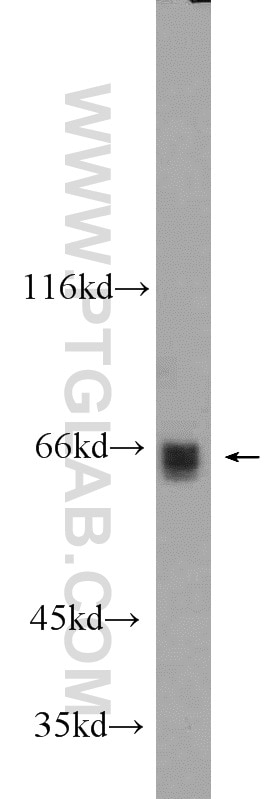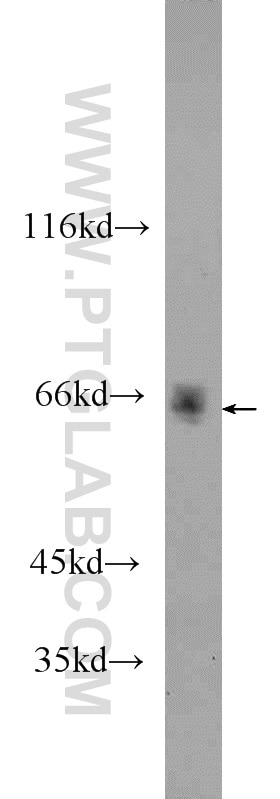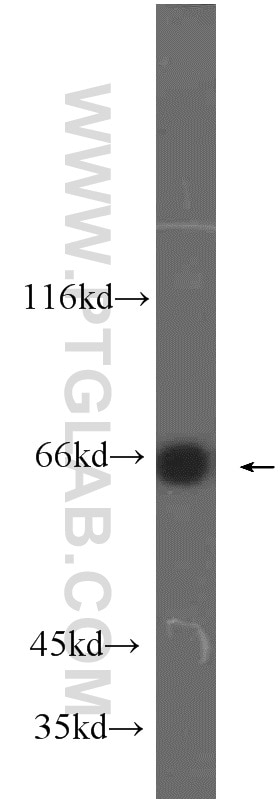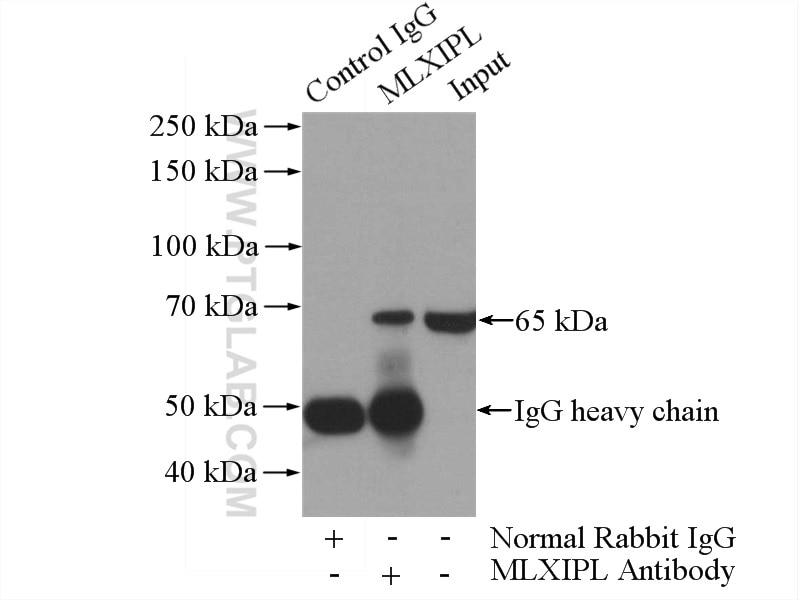Tested Applications
| Positive WB detected in | mouse liver tissue, human liver tissue, HepG2 cells, HeLa cells, rat liver tissue |
| Positive IP detected in | HepG2 cells |
Recommended dilution
| Application | Dilution |
|---|---|
| Western Blot (WB) | WB : 1:500-1:1000 |
| Immunoprecipitation (IP) | IP : 0.5-4.0 ug for 1.0-3.0 mg of total protein lysate |
| It is recommended that this reagent should be titrated in each testing system to obtain optimal results. | |
| Sample-dependent, Check data in validation data gallery. | |
Published Applications
| WB | See 16 publications below |
| IHC | See 1 publications below |
| IF | See 4 publications below |
Product Information
13256-1-AP targets MLXIPL in WB, IHC, IF, IP, ELISA applications and shows reactivity with human, mouse, rat samples.
| Tested Reactivity | human, mouse, rat |
| Cited Reactivity | human, mouse |
| Host / Isotype | Rabbit / IgG |
| Class | Polyclonal |
| Type | Antibody |
| Immunogen |
CatNo: Ag3481 Product name: Recombinant human MLXIPL protein Source: e coli.-derived, PGEX-4T Tag: GST Domain: 1-350 aa of BC012925 Sequence: MAGALAGLAAGLQVPRVAPSPDSDSDTDSEDPSLRRSAGGLLRSQVIHSGHFMVSSPHSDSLPRRRDQEGSVGPSDFGPRSIDPTLTRLFECLSLAYSGKLVSPKWKNFKGLKLLCRDKIRLNNAIWRAWYIQYVKRRKSPVCGFVTPLQGPEADAHRKPEAVVLEGNYWKRRIELPPEDAYVGNADMIQPDLTPLQPSLDDFMDISDFFTNSRLPQPPMPSNFPEPPSFSPVVDSLFSSGTLGPEVPPASSAMTHLSGHSRLQARNSCPGPLDSSAFLSSDFLLPEDPKPRLPPPPVPPPLLHYPPPAKVPGLEPCPPPPFPPMAPPTALLQEEPLFSPRFPFPTVPPA Predict reactive species |
| Full Name | MLX interacting protein-like |
| Calculated Molecular Weight | 852 aa, 93 kDa |
| Observed Molecular Weight | 65 kDa |
| GenBank Accession Number | BC012925 |
| Gene Symbol | MLXIPL |
| Gene ID (NCBI) | 51085 |
| RRID | AB_2266665 |
| Conjugate | Unconjugated |
| Form | Liquid |
| Purification Method | Antigen affinity purification |
| UNIPROT ID | Q9NP71 |
| Storage Buffer | PBS with 0.02% sodium azide and 50% glycerol, pH 7.3. |
| Storage Conditions | Store at -20°C. Stable for one year after shipment. Aliquoting is unnecessary for -20oC storage. 20ul sizes contain 0.1% BSA. |
Background Information
Carbohydrate response element-binding protein (ChREBP), also known as MLXIPL, is a glucose-responsive transcription factor that has a fundamental role in the glucose-mediated induction of genes involved in hepatic glycolysis and lipogenesis. Circulating blood glucose levels affect ChREBP activity in hepatocytes largely by post-translational mechanisms that include phosphorylation-dependent subcellular localization [PMID:21665952]. It enhances expression of the liver pyruvate kinase (LPK) gene and all lipogenic enzyme genes resulting in the conversion of excess dietary carbohydrate into triglycerides that can be stored as fat [PMID:15118080]. Molecular Weight of ChREBP splice variants: 62/78/91/93 kDa.
Protocols
| Product Specific Protocols | |
|---|---|
| IP protocol for MLXIPL antibody 13256-1-AP | Download protocol |
| WB protocol for MLXIPL antibody 13256-1-AP | Download protocol |
| Standard Protocols | |
|---|---|
| Click here to view our Standard Protocols |
Publications
| Species | Application | Title |
|---|---|---|
EMBO Rep Lin28 enhances de novo fatty acid synthesis to promote cancer progression via SREBP-1. | ||
Clin Transl Med Phosphoproteome reveals molecular mechanisms of aberrant rhythm in neurotransmitter-mediated islet hormone secretion in diabetic mice. | ||
Front Pharmacol Roxadustat, a Hypoxia-Inducible Factor 1α Activator, Attenuates Both Long- and Short-Term Alcohol-Induced Alcoholic Liver Disease. | ||
J Agric Food Chem Diosmetin Ameliorates Nonalcoholic Steatohepatitis through Modulating Lipogenesis and Inflammatory Response in a STAT1/CXCL10-Dependent Manner. | ||
J Agric Food Chem Baicalein Enhances the Effect of Acarbose on the Improvement of Nonalcoholic Fatty Liver Disease Associated with Prediabetes via the Inhibition of De Novo Lipogenesis. | ||
Food Funct Polysaccharide MCP extracted from Morchella esculenta reduces atherosclerosis in LDLR-deficient mice. |

